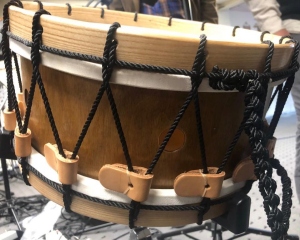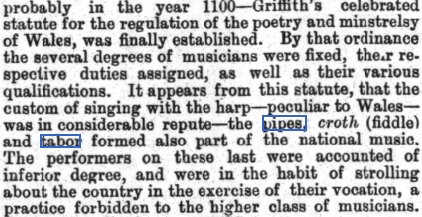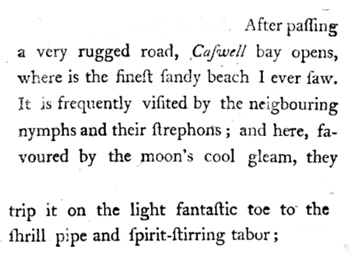Wales: history
|
tabwydd copy, 2018 |
The north Wales tabwrdd existed 700 years ago. 'Tabwrdd' and the English 'tabor' both come from the French 'tambour', a word which goes back to the Persian 'tabîr'. 'Bwrdd' means a board or table, which describes the drum as something you could have a meal off. Plural - tabyrddau; Drumstick- ffon dabwrdd, ffyn tabwrdd . There is a Welsh traditional pipe called a Pibgorn. It has a single reed and is played with two hands. |
|
taborers' position in society |
|
| Poets and musicians in Wales were part of an all-embracing bardic system. Except for taborers and few others.
The 12th-century Giraldus Cambrensis noted that Welsh musicians played the harp and pipes. 1402 in the time of Henry IV: These laws were passed in response to the Welsh Rising of 1400, and imposed The authorities had other reasons for watching over singers and itinerant musicians;... “Item: That no westours and rimers, minstrels or vagabonds, be maintained in Wales to make quyllages = tax “Rolls of Parliament,” iii. p. 508 in English Wayfaring Life in the Middle Ages, by J. J. (Jean Jules) Jusserand 1889 A late sixteenth-century hierarchy of minstrels contrasted the four types of graduate minstrel (poet, harper,
1808 source a reprint of a 1794 book This was confirmed in 1828:
|
|
1873 Newspaper commentary on 'The Eisteddfod at Mold':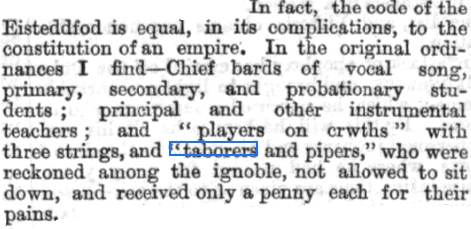 London Evening Standard - Wednesday 20 August 1873 London Evening Standard - Wednesday 20 August 1873 |
|
1889 a talk on ‘the Musical Instruments of Cymru Fu’ commented on Elizabethan minstrels:  Oswestry Advertiser - Wednesday 17 July 1889 Oswestry Advertiser - Wednesday 17 July 1889 |
|
| 1402
Henry IV’s punitive legislation against the Welsh enacted in 1402 and confirmed in 1446–47, included, significantly, a statute against minstrels who were classified as a type of vagabond. The Act referred to the "many diseases and mischiefs which have happened before this time in the land of Wales ..." page 150 |
|
In 1556 a general order was made by the Marian Council against ‘players and pipers’ strolling through the kingdom 1572 Orders at
Caernarfonshire Quarter Sessions, records The National Archives XQS/1571/77-80 Minstrels were prosecuted sporadically in Elizabethan Wales also, but it becomes increasingly difficult, especially The pipe and tabor became ‘exceeding common’ in the seventeenth-century border counties where ‘many Beggars |
|
Poets and pipers were in competition: the music was increasingly preferred to the poets’ words. ‘By the saints of |
|
The poets wrote verse of an occasional nature, including satirising certain people in verses which might have the intensity |
|
"Fie dinning tabor, unenjoyable song,
|
ffei dabwrdd dwmbwrdd difwynder / kanu ffei or kene sy iw harfer ffei or bib, nid offer ber ffei o adlais y ffidler. [ Peniarth MS 146 . |
| 1615 Rowland David of Narberth was prosecuted in 1615 not only for wandering up and down the country with his ‘fiddell or crowde’ but also for keeping two ‘preety’ youths whom he was training ‘in the same trade or scyence’. (page 143) |
|
John Aubrey wrote: “…When I was a boy, before the late civill warres, the tabor and pipe were commonly used, |
|
In 1620 the grand jury made a presentment of the fiddlers, harpers, crowders, tabor-players and pipers who |
|
“On 23 June 1653 William Lucas of Llansantffraid-ym-Mechain in Montgomeryshire was asked to play The Ancient English Morris Dance, 2023 |
|
In mid-seventeenth century Cardiganshire Griffith ap Evan of Caron was prosecuted for: |
|
There was a tabwrdd player living in Llandeilo in the 18th century. |
|
1723 November 1. Thomas Herbert of Eglwysilan, gentleman left in his will: Wills: 1719-1778 Cardiff Records: Volume 3. Originally published by Cardiff Records Committee, Cardiff, 1901. |
|
dancing to the pipe and tabor |
|
 'The Ancient English Morris Dance' by Michael Heaney, 2023 page 101 'The Ancient English Morris Dance' by Michael Heaney, 2023 page 101 |
|
In a satire on the fair, Siôn Mawddwy (fl. 1560–1613), an itinerant bard, described the alien music and dancing The instruments that the bards detested – fiddle, pipe and drum or tabor – were louder than the single-harp |
|
Poem by John Dyer (1699 –1757), painter and Welsh poet ‘While on the grass |
|
1743  A collection of Welch travels, and memoirs of Wales Page 23
by John Torbuck A collection of Welch travels, and memoirs of Wales Page 23
by John Torbuck |
|
1778 poem ‘ON THE APPROACH OF WINTER’ ‘Poems, Lyric and Pastoral ‘..
by Iolo, Morganwg, translated from Welsh ‘Poems, Lyric and Pastoral ‘..
by Iolo, Morganwg, translated from Welsh |
|
1797 Swansea |
|
1833 Shaftsbury Prize Byzant |
|
1840 The Ploughman  Silurian - Saturday 01 February 1840 Silurian - Saturday 01 February 1840 |
|
1878 fantasy poem: 'The Scenes of the Conway' By Ap Gyffyn  Caernarvon & Denbigh Herald - Saturday 04 May 1878 Caernarvon & Denbigh Herald - Saturday 04 May 1878 |
|
1883 May Queen ‘Harvest Heathenism’ Western Mail - Wednesday 25 July 1883 Western Mail - Wednesday 25 July 1883 |
|
1898 'The Sabbath and Mabon’s Day’ |
|
morris dancing in Wales |
|
There are only three dances that can really be described as Welsh morris; Y Gaseg Eira, and the processional Y Gaseg Eira (the snow horse, the Welsh name for a giant snowball) comes from Nantgarw in Glamorganshire, Cadi Ha (Cadi means Kate, Ha summer) comes from the Point of Ayr, in Flintshire and elsewhere in North Wales. |
|
mentions of the pipe and tabor |
|
? 1387 " And they Scotlond the douzter of Irlond use harpe, tymbre, and tabour, Dictionary of Middle English Musical Terms |
|
1749 whitsun ale “…Whitsun-ale is solemnized with festivity of fiddle, and celebrated with caper after pipe and tabor…” ‘A collection of Welsh travels, and memoirs of Wales. Containing, I. The Briton describ'd; or, a journey thro' Wales: |
|
1846 metaphor: |
|
1852 poem ' The Love of Song' by John B Pedler |
|
1852 Newspaper Correspondence: 'of Superstitious Ceremonies' by John Williams Caernarvon & Denbigh Herald - Saturday 10 January 1852 Caernarvon & Denbigh Herald - Saturday 10 January 1852 |
|
1852 Newspaper Correspondence: 'of Superstitious Ceremonies' cont.  Caernarvon & Denbigh Herald - Saturday 10 January 1852 Caernarvon & Denbigh Herald - Saturday 10 January 1852 |
|
1865 poem 'The Poet’s Pilgrimage' by Tom Hood Cardiff and Merthyr Guardian, Glamorgan, Monmouth, and Brecon Gazette - Friday 31 March 1865 Cardiff and Merthyr Guardian, Glamorgan, Monmouth, and Brecon Gazette - Friday 31 March 1865 |
|
1893  South Wales Daily News - Saturday 30 December 1893 South Wales Daily News - Saturday 30 December 1893 |
|
pipe and tabor not played like it used to be |
|
1892 ‘Jottings for Ladies’ South Wales Echo - Friday 06 May 1892 South Wales Echo - Friday 06 May 1892 |
|
1893 ‘Chepstow’s Fair – The Past and the Present’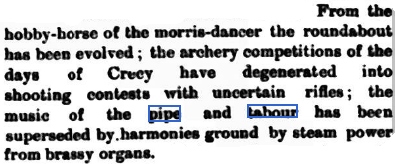 South Wales Weekly Argus and Monmouthshire Advertiser - Saturday 24 June 1893 South Wales Weekly Argus and Monmouthshire Advertiser - Saturday 24 June 1893 |
|
top of page
